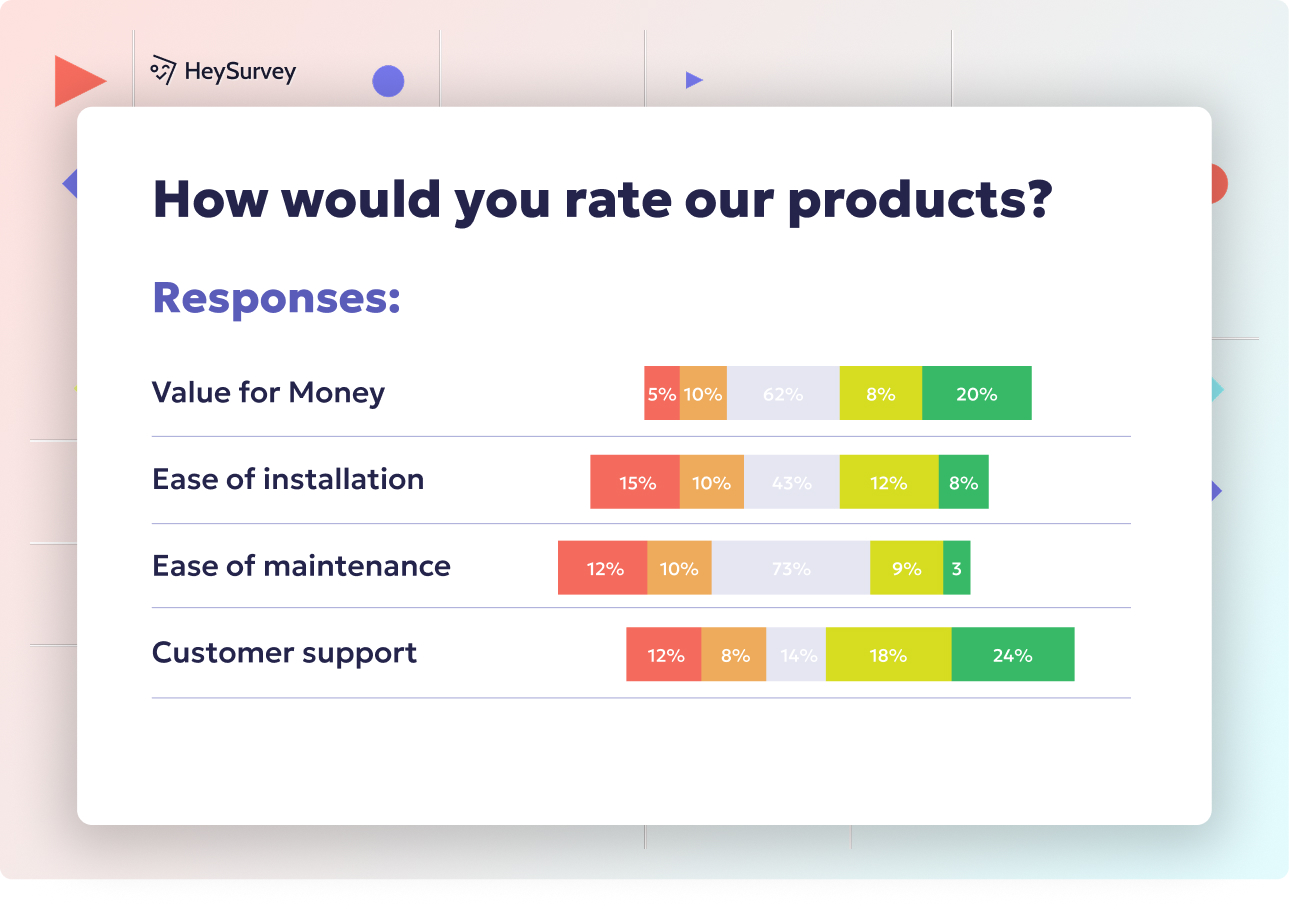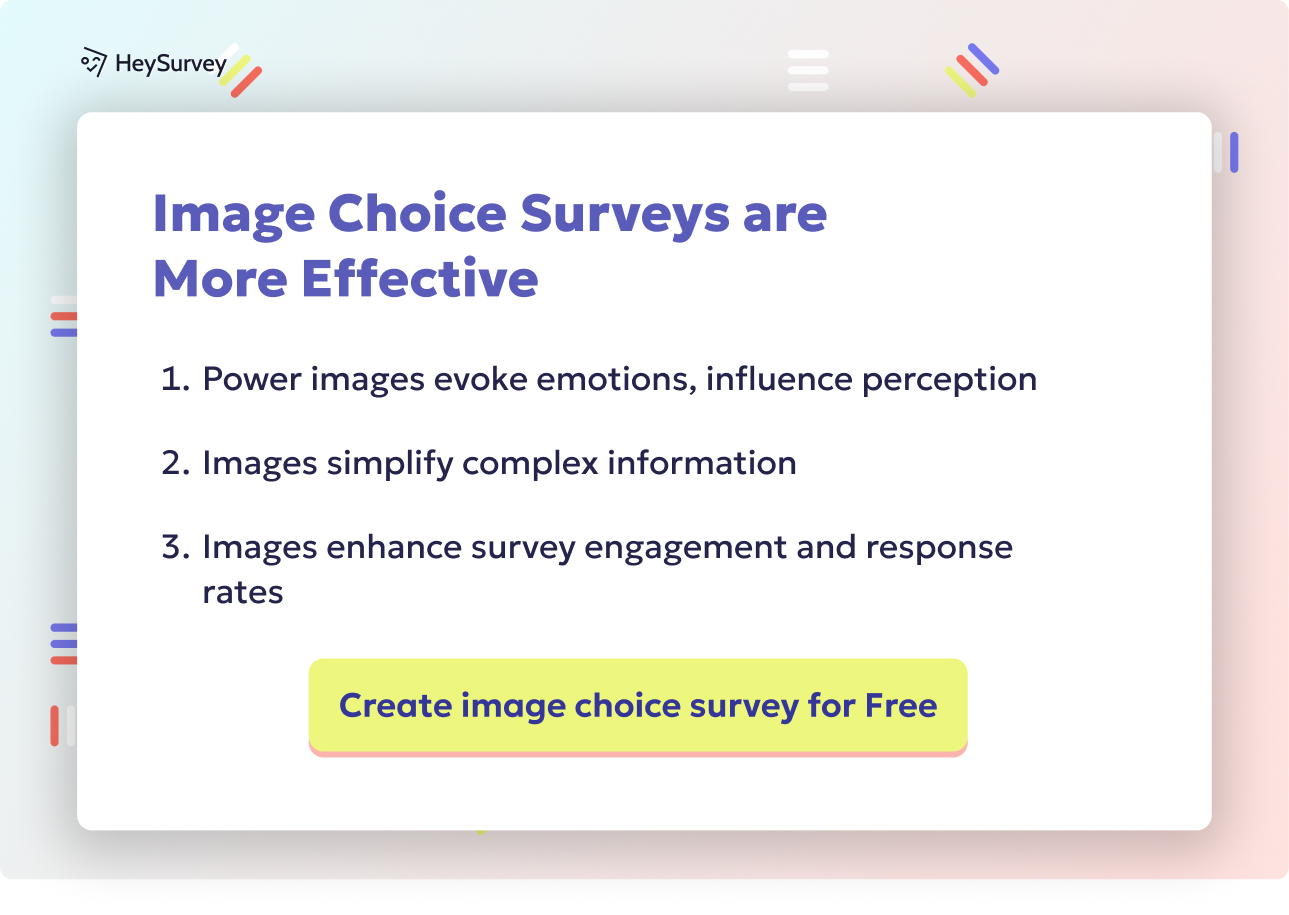32 Good Survey Question to Boost Your Data Quality
Discover how to craft good survey questions with 30 sample questions across 8 types for better data and insights.
Good survey questions are the foundation of collecting meaningful feedback, turning opinions into actionable data, and making smart business moves. Carefully crafted survey question types not only shape how well your data reflects reality, but they also boost the respondent’s mood and the accuracy of your analysis. Wondering when to design your next survey? Think about big moments like a product launch, checking customer satisfaction, running a quick employee pulse, or validating a new market idea. In this guide, we will unpack eight essential survey question types, from multiple-choice to open-ended—each tailor-made to unlock a different insight.
Multiple-Choice Questions (Single or Multiple Select)
The Format and Nature of Multiple-Choice
Let’s start with the perennial favorite: multiple-choice survey questions. This format presents a fixed set of possible answers, letting respondents select either one (single-select) or several (multiple-select) options. These are closed-ended questions, which means respondents can’t go rogue with their answers—everything stays within your defined list.
The clarity and control in this format make it a staple in almost every survey toolkit. Respondents appreciate the easy pick-and-click experience, and you’ll love the tidy data that’s a breeze to analyze. It’s a win-win.
Why and When to Use Multiple-Choice Questions
There are good reasons this type is everywhere. Multiple-choice survey questions shine when you:
- Need tidy, categorical data for fast reporting.
- Want to speed up completion, especially for mobile users with those tiny thumb keyboards.
- Know the answer options ahead of time, as with product features, purchase channels, or demographics.
Consider these for the opening rounds of any discovery study, or when you want to compare how often people select this-or-that feature or channel. If your goal is to spot trends quickly, this question style is your go-to.
Five Sample Multiple-Choice Survey Questions
Which of the following features do you use most often?
How did you first hear about our product?
What is your preferred delivery option?
Which age range applies to you?
Select all devices you use for online shopping.
Multiple-choice survey questions keep things snappy, simple, and structured, making them perfect for any survey where speed and comparability are top priorities.
Research indicates that multiple-choice questions with three plausible answer choices optimize assessment reliability and learning outcomes. (learningscientists.org)

Getting started with HeySurvey is a breeze, even if you’re brand new to the platform. Here’s a simple, three-step guide to help you create your survey—with a couple of bonus tips to polish things off.
Step 1: Create a New Survey
Open HeySurvey and click the button below the instructions to start with a ready-made template, or choose to create an Empty Sheet if you want full creative control.
Give your survey an internal name that helps you recognize it later (this name won’t be shown to respondents).
You’re now inside the Survey Editor, where all the magic begins.
Step 2: Add Questions to Your Survey
Click Add Question at the top or between existing items.
Pick your question type from the menu: multiple choice, yes/no, rating scale, semantic differential, ranking, matrix, open-ended, and more.
For each question, enter the question text and adjust settings, for example:
- Make it required if you want to ensure answers.
- Enable single or multiple selections for choice questions.
- Attach images or use markdown formatting to spice things up.
Keep adding as many questions as your survey needs.
Step 3: Publish Your Survey
Hit the Preview button to see how your survey looks and test the flow.
When you’re happy, click Publish.
If you don’t have an account yet, you’ll need to create one to publish and start collecting responses.
Once published, share your survey link or embed it on your website.
Bonus Step: Apply Your Branding
Open the Branding and Settings Panel to upload your logo and customize colors, fonts, and backgrounds via the Designer Sidebar.
This helps your survey look like “you” and builds trusting vibes with respondents.
Bonus Step: Define Survey Settings or Skip Into Branches
In the settings panel, set your survey’s start and end dates, limit responses, or specify where respondents should be redirected after finishing.
Use branching (skip logic) to send respondents down different paths based on their answers—perfect for a personalized survey experience.
Now you’re ready to create surveys with HeySurvey that capture smart insights with ease and style. Just start, add questions, polish with your branding, and publish. Happy surveying!
Dichotomous (Yes/No) Questions
Definition: The Two-Option Classic
Now onto yes/no survey questions, also affectionately known as binary survey questions. These questions keep things as simple as possible—respondents must pick one of two options: yes or no. There’s no room for maybe, perhaps, or “it depends.”
You’ll find these questions at the pulse of every qualifying moment in surveys, keeping everything wonderfully straightforward.
Why and When to Use Dichotomous Questions
Why pick this format? Binary survey questions excel when:
- You need a quick screening or qualification.
- It’s important to route people—think of that fork-in-the-road question at the start of a survey.
- Checking a single behavior or commitment with crystal clarity.
- You want no ambiguity and a direct answer, especially for key decision points.
These are best used upfront to filter participants or at the end for those little “final nudge” moments (like opting into newsletter, anyone?). They’re also fabulous for pulse-checks during a longer questionnaire.
Five Sample Dichotomous Survey Questions
Did you complete your purchase today?
Would you recommend us to a friend?
Are you willing to participate in follow-up research?
Have you used our mobile app in the last month?
Do you agree to receive promotional emails?
Yes/no survey questions are the workhorses of routing and fast data gathering—short, sweet, and to the point.
Dichotomous (yes/no) questions are easy for respondents to answer and facilitate quick data collection, but they may not capture the full complexity of respondents' feelings, as they limit choices to just two options. (library.fiveable.me)
Rating Scale (Likert) Questions
Defining the Likert Scale
Time for a crowd favorite: Likert scale survey questions (often called rating scale questions). Here, respondents pick a point on a continuum—usually a five- or seven-point scale—that reflects their level of agreement, satisfaction, or frequency.
The setup? You ask a specific question and give options that typically range from “Strongly Disagree” to “Strongly Agree.” It’s all about measuring intensity, not just presence.
Why and When to Use Likert Scale Questions
If you’re looking to tap into sentiment—how people feel—this is your magic bean. Rating scale questions are brilliant when you want to:
- Gauge attitudes or opinions (like “Was this helpful?”).
- Measure satisfaction or likelihood (net promoter score, anyone?).
- Assess behavior frequency (weekly, monthly, rarely, etc.).
They show their true power in post-launch product surveys, employee engagement studies, or after someone interacts with your service or app.
Five Sample Likert Scale Survey Questions
How satisfied are you with the onboarding process?
Rate your agreement: “The website is easy to navigate.”
How likely are you to renew your subscription?
Rate the value for money of our service.
How frequently do you use our chat support?
Likert scale survey questions dig into nuance, revealing the shades of gray in how respondents experience your product or service.
Semantic Differential Questions
What Is a Semantic Differential Question?
Let’s talk nuance. Semantic differential survey examples use a scale anchored by bipolar adjective pairs (like “Unreliable” vs. “Reliable”). Respondents slide along a spectrum (say, 1 to 7) to show where their feelings sit between the polar extremes.
This format is subtle, giving a sense of texture to perceptions that would be missed by a simple thumbs-up or thumbs-down.
Why and When to Use Semantic Differential Scale
These questions are perfect when tapping into deeper perspectives, such as:
- Exploring how people view your brand, from personality to presentation.
- Collecting pre-post responses in brand perception or UX redesign studies.
- Grabbing the vibe of your product, interface, or team culture—are you seen as innovative or traditional?
They’re tailor-made for surveys following visual changes, brand refreshes, or to tease out personality attributes in crowded markets.
Five Sample Semantic Differential Survey Examples
Unreliable 1 2 3 4 5 6 7 Reliable
Dull 1 2 3 4 5 6 7 Exciting
Complicated 1 2 3 4 5 6 7 Simple
Traditional 1 2 3 4 5 6 7 Innovative
Impersonal 1 2 3 4 5 6 7 Personal
A semantic differential survey example can unlock the mental shortcuts people take when thinking of you—pinpointing what needs changing or amplifying.
Semantic differential scales, utilizing bipolar adjective pairs, effectively measure subjective perceptions and attitudes across diverse cultures. (en.wikipedia.org)
Ranking Questions
The Structure of Ranking Questions
On to something a little more competitive: ranking survey questions. Here, respondents must order a list of items according to preference, relevance, or value—think of it as inviting them to play favorites (no guilt attached).
This format goes beyond picking an option; it asks for judgment, forcing trade-offs and revealing priorities.
Why and When to Use Ranking Questions
Ranking works wonders when:
- You must have a pecking order—like when developing a product roadmap.
- Respondents have to choose what’s most (or least) important.
- You want to see what bubbles up to the top for buyer motivation or feature demand.
They’re ideal after brainstorming sessions, for prioritizing product backlog, or in any moment requiring clarity on what's most valued among many options.
Five Sample Ranking Survey Questions
Rank these features from most to least valuable.
Order the following purchase factors by importance.
Prioritize improvements you’d like to see next.
Arrange these packaging options from most to least appealing.
Rank rival brands you consider before buying.
Ranking survey questions transform a flat list into a prioritized dataset—making it simple to see what matters most to your audience.
Matrix (Grid) Questions
What Are Matrix (Grid) Questions?
Let’s get efficient. Matrix survey questions (sometimes called grid questions) let you combine several related items with a shared set of response options, presented as a table.
Imagine rating a bunch of product elements on satisfaction, all within a tidy one-stop grid. Grid questions are the organizational ninjas of the survey world.
Why and When to Use Matrix Questions
- Help reduce survey length by clustering similar questions.
- Create a consistent rating experience, especially valuable in product reviews or employee feedback.
- Gather fast, comparable insights across many aspects.
Caution: Keep an eye on respondent fatigue! Too many rows can make even the most enthusiastic survey taker wilt, so use these with care—brevity is your friend.
Five Sample Matrix Survey Statements
The checkout process is straightforward.
Customer support responds quickly.
Product descriptions are clear.
Pricing is transparent.
Delivery times meet my expectations.
Matrix survey questions deliver a balance of breadth and efficiency, keeping your survey neat and reducing repetition while diving deep into related experiences.
Open-Ended Questions
Defining Open-Ended Survey Questions
Here comes the wildcard. Open-ended survey questions leave the box wide open, inviting respondents to write whatever they wish. There are no preset answers here—just pure, unfiltered feedback.
This format brings the richness of stories, allowing you to capture details and perspectives that structured options simply miss.
Why and When to Use Open-Ended Questions
Open-ended questions are gold when you want:
- Qualitative survey insights that explain the “why” behind the numbers.
- Natural language, ideas, and unexpected comments.
- Rich detail to complement earlier closed-ended answers.
Best used at the end of a survey, or as a follow-up for specific responses, these questions dig into the motivations, barriers, or quirky thoughts that numbers can’t show.
Five Sample Open-Ended Survey Questions
What almost stopped you from completing your purchase?
Describe one feature you wish our product had.
In your own words, why do you prefer our brand?
What can we improve about our mobile experience?
Is there anything else you’d like to share with us today?
Open-ended survey questions are your passport to unexpected insight—making sure every voice has room to surprise you.
Best Practices & Dos and Don’ts for Writing Good Survey Questions
If you want your survey to shine, follow these best practices for survey questions. Each step helps you steer clear of pitfalls and keep your data sparkling clean.
The Golden Rules
- Define clear objectives before drafting questions.
- Keep language simple, neutral, and jargon-free.
- Randomize answer order to avoid unconscious bias (except for logical scales!).
- Double-check that every question tackles only one idea at a time.
Watch Out for These Pitfalls
- Don’t double-barrel your questions (“Do you find our app fast and easy?”—what if one is true and not the other?).
- Avoid loaded questions or leading language that makes assumptions about the respondent’s view.
- Make time to pilot test on a small audience before launching big.
- Optimize for mobile and accessibility so everyone can participate easily.
A truly good survey question is one that fits the objective, respects the respondent’s time and perspective, and sets the stage for reliable insights. Keep it light, keep it clear, and don’t be afraid to iterate. The path to great insights starts with a single, well-crafted question.
Crafting effective survey questions isn’t just about following rules—it’s about unlocking understanding with every click and comment. Ask thoughtfully, listen closely, and you’ll be on your way to better decisions and a more engaged audience. Cheers to smarter questions, deeper insights, and happier respondents!
Related Question Design Surveys

29 Quantitative Survey Research Questions Example for Success
Explore 25+ quantitative survey research questions example with clear explanations and tips for c...

31 Survey Question Mistakes You Need to Avoid Today
Discover 25 common survey questions mistakes with real examples and expert tips to craft clear, u...

29 Fun Survey Questions Ideas to Engage, Entertain & Learn
Explore 25+ fun survey questions ideas to engage, entertain, and gather valuable insights with cr...